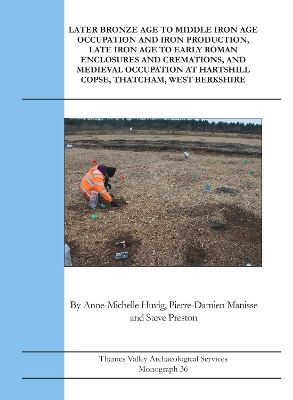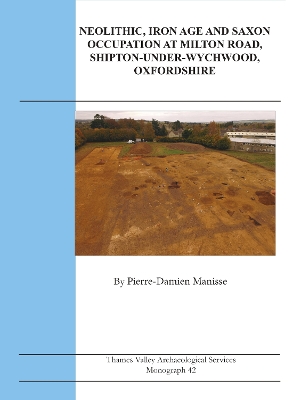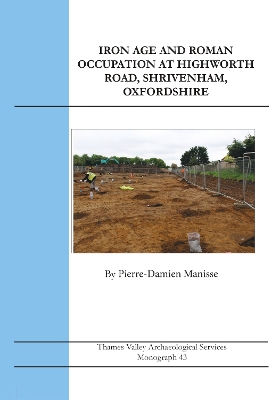TVAS Monograph
3 primary works
Book 36
Excavations in advance of gravel extraction on a 10ha site revealed a landscape occupied from the Later Bronze Age to the early Roman period, with later use in the Medieval period. The site published here complements a significant excavation to the south which had produced evidence for the earliest iron working in Britain. The results help to set the south site into its local landscape context, and also cover a longer timespan.
A single Middle Bronze Age pit was followed by numerous Late Bronze Age to Early Iron Age pits, best classed as a dispersed open settlement. Finds of smelting slag from this period confirm the early dating for the iron working found to the south. Middle and Later Iron Age features also mostly comprised pits and postholes with no clear structural associations, although a ring ditch and up to a dozen post-built roundhouses can be projected and the continuation of a large enclosure from the earlier site. An area of industrial activity included more iron production from the 6th century BC onwards. Three pit alignments were also identified, one containing a density of iron slag. One pit also contained a quantity of acorns, a rarity on British sites.
Two late Iron Age urned cremations were identified, and one Roman, and several deposits of pyre debris may be of either period. Late Iron Age to early Roman ditches represented three phases of an enclosure, likely part of a wider organization of the landscape at this time. Two iron-smelting hearths were identified, one of which contained in situ slag from the last firing of the furnace. All of the Roman deposits dated from the mid-1st to 2nd century AD. This early abandonment is in contrast to the later Roman date for the few Roman features to the south, so that a southwards shift in the focus of activity seems to be indicated rather than outright abandonment.
The Medieval period was represented by a small isolated farm dated to the 11th to 12th centuries AD, although economic evidence was very sparse.
The site's chronology is supported by an extensive radiocarbon dating programme and this volume includes reports on substantial assemblages of pottery (mostly prehistoric), metallurgical residues, and charred plant remains, but soil conditions were not favourable to the survival of most other classes of finds.
A single Middle Bronze Age pit was followed by numerous Late Bronze Age to Early Iron Age pits, best classed as a dispersed open settlement. Finds of smelting slag from this period confirm the early dating for the iron working found to the south. Middle and Later Iron Age features also mostly comprised pits and postholes with no clear structural associations, although a ring ditch and up to a dozen post-built roundhouses can be projected and the continuation of a large enclosure from the earlier site. An area of industrial activity included more iron production from the 6th century BC onwards. Three pit alignments were also identified, one containing a density of iron slag. One pit also contained a quantity of acorns, a rarity on British sites.
Two late Iron Age urned cremations were identified, and one Roman, and several deposits of pyre debris may be of either period. Late Iron Age to early Roman ditches represented three phases of an enclosure, likely part of a wider organization of the landscape at this time. Two iron-smelting hearths were identified, one of which contained in situ slag from the last firing of the furnace. All of the Roman deposits dated from the mid-1st to 2nd century AD. This early abandonment is in contrast to the later Roman date for the few Roman features to the south, so that a southwards shift in the focus of activity seems to be indicated rather than outright abandonment.
The Medieval period was represented by a small isolated farm dated to the 11th to 12th centuries AD, although economic evidence was very sparse.
The site's chronology is supported by an extensive radiocarbon dating programme and this volume includes reports on substantial assemblages of pottery (mostly prehistoric), metallurgical residues, and charred plant remains, but soil conditions were not favourable to the survival of most other classes of finds.
Book 42
Book 43
Iron Age and Roman Occupation at Highworth Road, Shrivenham, Oxfordshire
by Pierre-Damien Manisse
Published 1 July 2022
Archaeological excavation in advance of a housing development has recorded a parcel of land densely occupied in the Early and Middle Iron Age with numerous post-built and ring-gully houses forming an unenclosed settlement. Many of the structures had been refurbished on several occasions or simply replaced, indicating considerable time depth to the use of the site. Faunal remains recovered indicated the animal husbandry practiced, with cattle and sheep being dominant and with a mix of younger animals for consumption and older animals kept for milk, wool or traction rather than meat. Charred plant remains suggest a strong emphasis on the growing of barley with few other food species represented, perhaps indicating a regional preference for this crop. Very limited evidence was also
recovered for the selective disposal of human remains, including a rare trepanned skull fragment. There was also a series of special deposits of animal bones. Occupation of the site is thought to have ceased at the end of the Middle Iron Age but the area was subsequently incorporated within an area of Roman land-use that might have commenced at the end of the Late Iron Age. Although the boundary features were of substantial size and were recut several times, and despite the
presence of several wells, the volume of cut features and artefacts of this period was relatively modest, suggesting that the focus of the Roman settlement lay elsewhere. Use of the site declined after the 2nd century AD with just a few sherds of pottery of 3rd- or 4th-century date recovered. The chronology is supported by a series of four radiocarbon dates. Fairly substantial assemblages of pottery and animal bone are reported on, but other finds were relatively sparse.
recovered for the selective disposal of human remains, including a rare trepanned skull fragment. There was also a series of special deposits of animal bones. Occupation of the site is thought to have ceased at the end of the Middle Iron Age but the area was subsequently incorporated within an area of Roman land-use that might have commenced at the end of the Late Iron Age. Although the boundary features were of substantial size and were recut several times, and despite the
presence of several wells, the volume of cut features and artefacts of this period was relatively modest, suggesting that the focus of the Roman settlement lay elsewhere. Use of the site declined after the 2nd century AD with just a few sherds of pottery of 3rd- or 4th-century date recovered. The chronology is supported by a series of four radiocarbon dates. Fairly substantial assemblages of pottery and animal bone are reported on, but other finds were relatively sparse.


